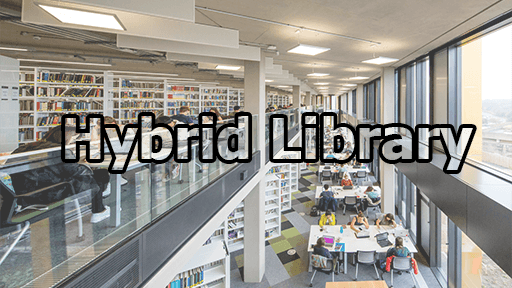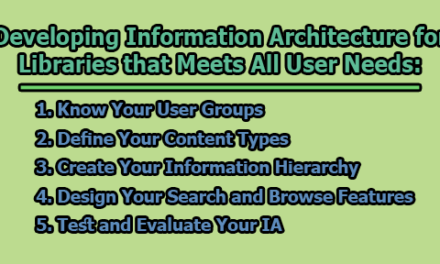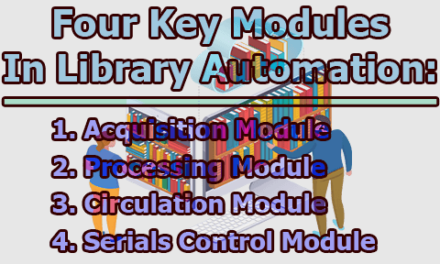In an age where information is increasingly digitized and accessible online, the concept of a “Hybrid Library” has emerged as a revolutionary approach to information access and learning. This innovative model seamlessly combines the timeless allure of physical resources with the dynamic potential of cutting-edge digital technologies. The Hybrid Library envisions a learning environment that caters to diverse preferences and learning styles by integrating traditional print materials with digital databases, multimedia resources, and interactive platforms. In the rest of this article, we will explore the features, advantages, challenges, and strategies that shape the trajectory of a Hybrid library.
Hybrid Library:
Hybrid libraries are the mixture of traditional print materials such as books and magazines, as well as electronic based materials such as downloadable audiobooks, electronic journals and e-books. Hybrid libraries are the new norm in most public and academic libraries. The term “hybrid library” was first coined in 1998 by Chris Rusbridge in an article for D-Lib Magazine.
Hybrid libraries evolved in the 1990s when electronic resources became more easily available for libraries to acquire for public use. Initially these electronic resources were typically access to material distributed on media such as CD-ROM or searches of specialized databases. Online computer library center helped push libraries towards acquiring digital resources by providing a centralized technology resources for participating libraries. Now, with the widespread availability of digital content, it includes Internet resources and documents which are online, such as e-prints.
Hybrid libraries are the new norm for many archivists as well. Digitization has changed the way archivists have gone about preserving historical items. Archivists are now using digital technology to preserve items that were once only preserved by things like microfiche. Archivists now use things like digital imaging which make it possible for researchers to see historical items online.
The emergence of the hybrid library has put a new emphasis on copyright issues for many libraries. The complicated and changing copyright laws in both the United States and the European Union have made it a challenge for many libraries to make sure their patrons are using the digital items lawfully.
Hybrid libraries need staff that are trained in helping patrons navigate the vast amount of information available in the digital age. Librarians working in hybrid libraries have training in electronic media as well as the traditional print forms.
Issues in Hybrid Library:
Some of the issues faced by the hybrid libraries are the digital divide, collection development, ownership of electronic resources and preservation of digital media.
Any advancement in information technology will be useful only when a person know how to use it. The term digital divide is used to describe the gap between those with information technology knowledge and those who do not.
Now majority of the libraries are hybrid libraries. The libraries own and subscribe to different resources in different formats. Some of the common formats are e-journals, serials, print monographs, CD and DVD. The main components of digital library framework are user interfaces, repository, handle system, and search system. The handle system and search system are the major components that should be designed with interoperability features to search across different repositories owned by different vendors. The user interface should be designed in a generic way that it helps library patrons develop a common knowledge to do advanced searches across all repositories.
Technology Preservation, Emulation, and Migration:
In technology preservation, both hardware and software related to digital information are preserved. This may not be cost effective because changes to hardware and different versions of software need to be either maintained or constantly upgraded. In emulation, some emulator software programs will mimic the hardware and software of the original data and display in the original format. In migration, digital information is converted to a standard media with standard format.
The hybrid library is a term used to describe libraries containing a mix of traditional print library resources and a growing number of electronic resources. Hybrid libraries are the new norm in most public and academic libraries (Rai, 2007).
The hybrid library is basically a combination of different types of library systems with different functions and services. Starting from collection to services, everything is of heterogeneous in nature. Hybrid library was designed to bring a range of technologies from different sources together in the context of a working library, and also to begin to explore integrated systems and services in both the electronic and print environments. The hybrid library should integrate access to different kinds of resources, using different technologies from the digital library world, and across different media. The name hybrid library is intended to reflect the transitional state of the library, which today can be neither fully print nor digital. Besides print collection, there are also the electronic resources in the library. Some housekeeping works are done through Library Management Software (LMS) whereas others are through traditional way; some collections are digitized and rest are printed. It is actually the transitional state between the traditional and automated libraries. The hybrid library tries to use the technologies available to bring things together into a library reflecting the best of both printed and electronic world.
The hybrid library (Pinfield et al., 1998; Brophy & Fisher 1998, Oppenheim & Smithson. 1999) is generally viewed by its proponents as a model in its own right, to be developed and improved, though it may be viewed by others as a transitional stage towards a truly digital library. This model represents the typical ‘real world’ situation, with within an ideal of ever-closer integration and interoperability; it follows that most users will continue to be offered a mix of formats via a mix of delivery system. The challenge for library managers is to create integrated service which provide a ‘seamless’ service to the user (Brophy & Fisher, 1998).
The hybrid library, since it has an element of physical provision and by implication a physical location in which these are stored and accessed, seems almost invariably to be an institutional model. In this way, it preserves the general concept of the traditional library, and, almost incidentally, retains the notation of the library as place; although there is considerable debate in the literature as to whether such an entity is properly regarded as primarily a place or a distributed process. Nevertheless, it seems clear that there will be a physical location associated with a hybrid (or gateway) library. The value of this should not be under-estimated, whether as the provision of space for student study in an educational institution, for community activities in a public library, or for knowledge management in a commercial organization, for which the physical conditions for knowledge sharing are being increasingly recognized as important. The hybrid library, for the same reasons, has an extended temporal existence.
Features of a Hybrid Library:
The modern era is marked by rapid technological advancements that have significantly transformed the way we access and engage with information. In response to this digital revolution, the concept of a Hybrid Library has emerged as a transformative paradigm, seamlessly merging the traditional realm of physical resources with the dynamic landscape of digital technologies. This innovative approach revolutionizes how individuals interact with information, learn, and conduct research. Here, we delve into the distinct features that characterize a Hybrid Library, highlighting its role as a bridge between tradition and innovation in the realm of education and knowledge dissemination.
1. Seamless Integration of Physical and Digital Resources: At the heart of the Hybrid Library lies the concept’s namesake feature: the harmonious coexistence of physical and digital resources. Traditionally, libraries were synonymous with shelves laden with books and print materials. However, the Hybrid Library transcends this limitation by integrating traditional print holdings with an array of digital assets such as e-books, online databases, multimedia content, and interactive platforms (Oppenheim & Smithson, 1999). This seamless integration offers users the tactile satisfaction of interacting with physical books while providing access to the expansive world of digital resources. This dynamic blend of media caters to diverse learning styles and preferences, ensuring a comprehensive learning experience within a single environment.
2. Accessibility Beyond Boundaries: One of the most transformative features of the Hybrid Library is its capacity to break down physical boundaries. Unlike traditional libraries, where users are required to be present on-site, a Hybrid Library offers remote access to its digital resources. Learners and researchers can engage with materials from the comfort of their homes, libraries, or even on the go, providing unparalleled flexibility (Oppenheim & Smithson, 1999). This global accessibility facilitates collaboration among individuals irrespective of geographical location, transforming the library into a hub of virtual scholarly exchange.
3. Customizable and Interactive Learning Experience: Personalization takes center stage in the Hybrid Library experience. Patrons are empowered to tailor their learning journey according to their preferences. They can bookmark pages, highlight text, annotate digital materials, and even participate in virtual discussions with fellow learners (Oppenheim & Smithson, 1999). This interactive dimension fosters a sense of engagement and community within the digital realm, enhancing the overall learning experience. As a result, the Hybrid Library transcends its role as a repository of information and transforms into a platform that encourages active participation and collaboration.
4. Dynamic Data Analytics: Data-driven insights are a hallmark feature of the Hybrid Library. By analyzing user behavior and preferences, libraries can refine their offerings, curate collections, and anticipate evolving needs (Oppenheim & Smithson, 1999). This analytical approach ensures that the library remains relevant and responsive to the ever-changing demands of its users. By harnessing the power of data, the Hybrid Library becomes not only a source of information but also a space that continuously evolves to meet the evolving requirements of modern learners and researchers.
5. Preservation of Cultural Heritage: While the Hybrid Library embraces digital resources, it also recognizes the value of preserving cultural heritage. Rare manuscripts, vintage books, and historical documents are digitized, making them accessible to a wider audience while safeguarding their physical integrity for future generations (Oppenheim & Smithson, 1999). This preservation effort underscores the library’s commitment to maintaining a connection with the past while catering to the needs of the present and future.
6. Convergence of Multimedia Content: In addition to textual resources, the Hybrid Library introduces a diverse range of multimedia content. From educational videos and interactive simulations to podcasts and visual presentations, this convergence of media types caters to various learning preferences and engages users in a holistic manner (Oppenheim & Smithson, 1999). By offering a multifaceted learning experience, the library becomes a space that accommodates different ways of absorbing information, enhancing comprehension and engagement.
Advantages of Hybrid Libraries:
The main advantage of this form of library is that information can be accessed in print and non-print form. The modern libraries are,
- Systematic and organized collection of print and non-print resources.
- The acquisition, storage, disseminates, & retrieval of information is done by the use of technology.
- Access of entire holding of library is directly or indirectly accessible across the network with the help of internet and
- Supports and provides more & better online & offline services.
Challenges of Hybrid Library Professionals:
Libraries are supplementing and replacing print resources with electronic resources at a fast pace and almost all of the electronic resources are now available on the web. One of the advantages of web environment as compared to print environment is that one could link from one document to another logically related document very easily. As more information resources become available electronically on the web, linking becomes even more important to researchers.
The libraries all over the world are now responding with adaptability, creativity and flexibility. Indian librarians of today serve in a society which is actually in flux, torn by the technological revolution and rapid political changes. Librarians and information professionals in Indian are now experiencing both excitement and anxiety as a result of the sweeping societal changes. The major challenges faced by librarians of hybrid libraries are:
- Complexity in locating and analyzing and linking of Information;
- Overloading redundancy of information;
- Lack of Standardization of hardware and software;
- Financial investment for setting and maintaining the technology;
- Interpretability of Intermediary and end users;
- The existing technology may be insufficient to accommodate the tremendous growth of information on Internet.
How does it differ from a typical library?
A Hybrid Library differs from a typical or traditional library in several key ways, primarily due to its incorporation of digital technologies and its ability to adapt to modern information access and learning preferences. Here are some of the key differences:
- Integration of Physical and Digital Resources:
- Hybrid_Library: Combines physical collections (books, manuscripts, etc.) with digital resources (e-books, databases, multimedia content).
- Typical Library: Primarily houses physical resources with limited or no digital presence.
- Global Accessibility:
- Hybrid_Library: Offers remote access to digital resources, enabling users to engage with materials from anywhere with an internet connection.
- Typical Library: Requires users to be physically present at the library to access resources.
- Personalization and Interaction:
- Hybrid_Library: Provides personalized experiences through bookmarking, annotations, and interactive features. Facilitates online discussions, virtual study groups, and collaborative projects.
- Typical Library: Offers limited personalization options and primarily focuses on providing physical resources.
- Data-Driven Insights:
- Hybrid_Library: Utilizes data analytics to understand user behavior and preferences, which informs collection development and resource curation.
- Typical Library: May not have comprehensive data analytics capabilities to tailor services based on user behavior.
- Multimedia Integration:
- Hybrid Library: Incorporates multimedia content such as videos, podcasts, and interactive simulations to cater to various learning styles.
- Typical Library: Primarily offers printed materials, with limited multimedia resources.
- Preservation of Cultural Heritage:
- Hybrid Library: Digitizes rare and fragile materials for wider access while preserving their physical integrity.
- Typical Library: Focuses on physical preservation without extensive digitization efforts.
- Adaptive Learning Technologies:
- Hybrid Library: May leverage adaptive learning technologies to provide personalized recommendations and resources.
- Typical Library: Lacks advanced adaptive learning technologies for tailored resource suggestions.
- Virtual Reality (VR) and Augmented Reality (AR):
- Hybrid Library: Explores VR and AR technologies for interactive educational experiences.
- Typical Library: Does not typically incorporate VR and AR technologies.
- Continuous Evolution:
- Hybrid Library: Adapts to technological advancements, introducing new tools, platforms, and resources.
- Typical Library: May have limited capacity to incorporate emerging technologies due to traditional infrastructure.
- Learning Environment:
- Hybrid Library: Offers a dynamic and interactive learning environment that caters to modern learners’ preferences and habits.
- Typical Library: Provides a serene and contemplative atmosphere, often associated with traditional scholarly pursuits.
In conclusion, the traditional concept was changed in modernization of libraries. The new technologies are introduced in the information age to satisfy the user needs. Automation and computerization tasks are taken up and completed by the libraries to provide immediate services to the users. Libraries started using electronic and microelectronic equipment’s for processing and communication of information to its users. The use of telephone, radio, television, satellite transmission, computer, microprocessors are replaced by floppies, diskettes, CD-ROMs, DVDS, Pen drives, Portable Hard Discs to provide infinite storage space of information. The libraries to provide the information to the user 24/7. The staff in the library should have proper skills to process the information and disseminate to the users where the world is under globalization, privatization and liberalization. Libraries are the providers of information, processors of standard information using information technology and networking facilities.
The Hybrid Library represents an ingenious convergence of tradition and innovation, redefining how individuals interact with and explore information. By seamlessly blending physical and digital resources, offering remote accessibility, promoting personalization, fostering interactivity, harnessing data analytics, preserving cultural heritage, and converging multimedia content, the Hybrid Library stands as a pioneering concept poised to reshape education and research.
References:
- Arulmathi, R., Mary, A.L., & Kannan, K. (2019). Role of Hybrid System in the Circulation section. Journal of Emerging Technologies and Innovative Research, 6(5), 163-168.
- Arulmathi, R., & Mary, A.L. (2019). Challenges of managing hybrid libraries by the library professionals in manonmaniam sundaranar university region. Department of Library and Information Science, Manonmaniam Sundaranar University Created and maintained by INFLIBNET Centre. http://hdl.handle.net/10603/341870
- Chris Rusbridge, (1998). Towards the Hybrid Library, D-Lib Magazine. http://www.dlib.org/dlib/july98/rusbridge/07rusbridge.html.
- Oppenheim, C., & Smithson, D. (1999). What is the hybrid library? Journal of Information Science, 25(2), 97–112. https://doi.org/10.1177/016555159902500202
- Pinfield S. (1999). The Hybrid Library: a review from the UK. 4(1), 3-21.http://www.ukolo.ac.uk/services/elib.

Library Lecturer at Nurul Amin Degree College










